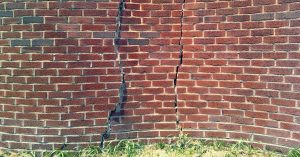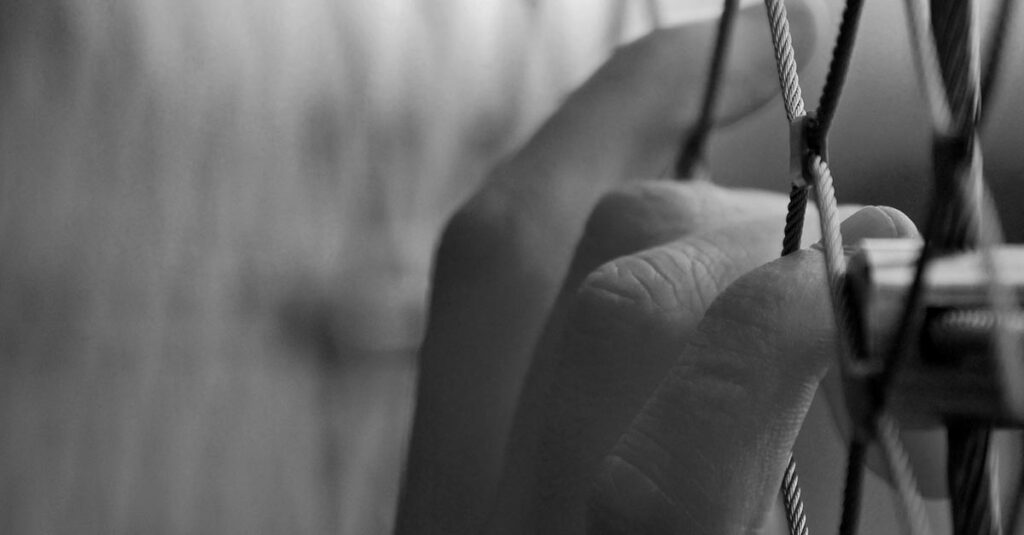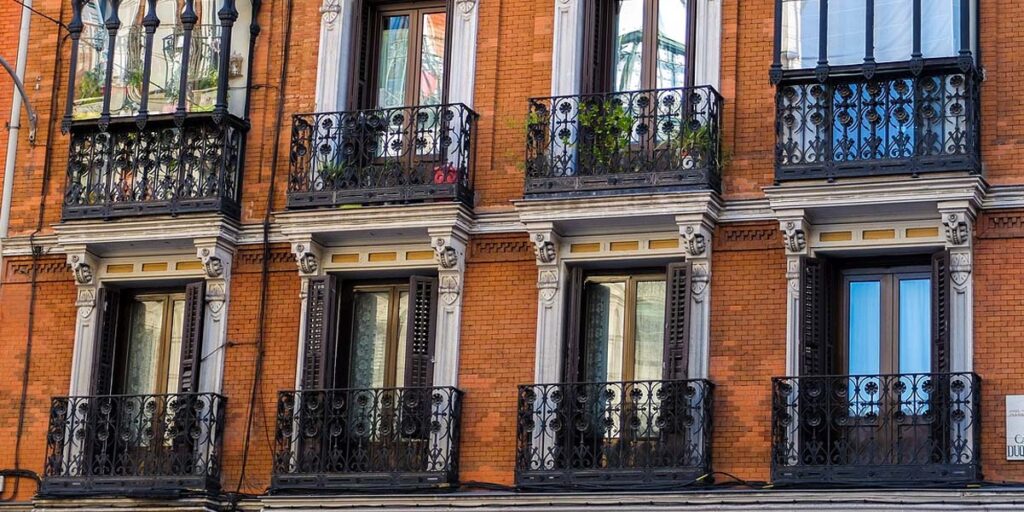Humidity in homes and communities of owners
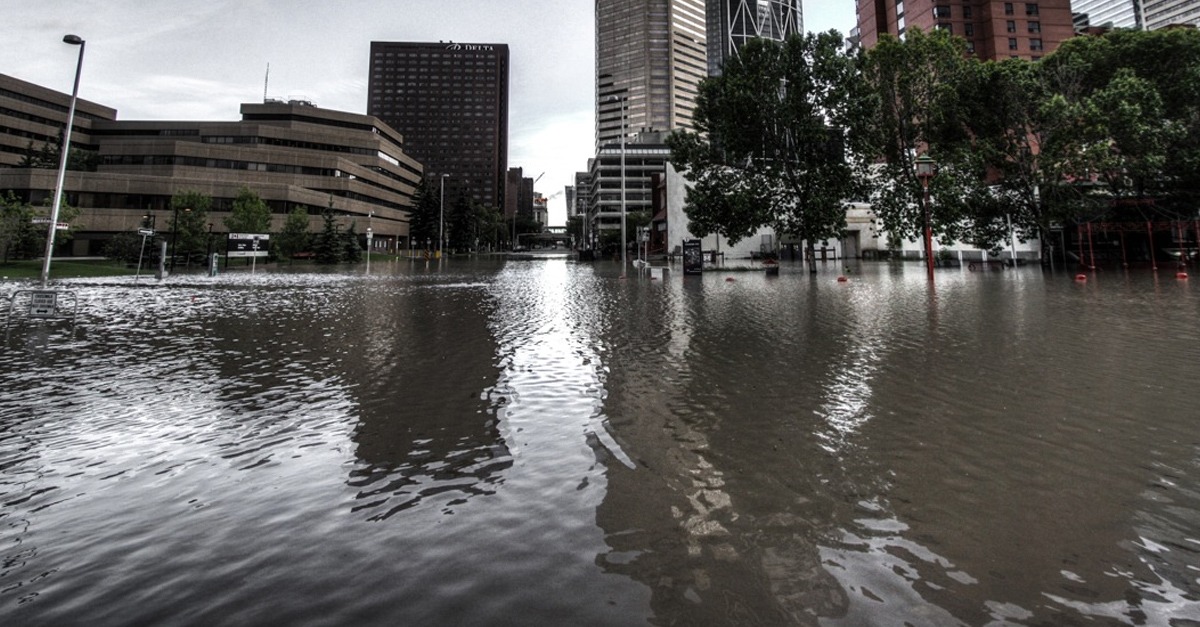
We are going to explain a recurring problem in real estate law, consisting of the appearance of dampness in the dwellings of the buildings.
The first question usually asked by those who suffer from these construction defects is: Should the homeowner or the community of owners pay for the repair works?
To answer the question, we must first find out the cause that is generating the humidity. In general terms, we can affirm that the owner will be responsible for carrying out the repair work when the cause of the humidity comes from a defect in the private elements; while the community of owners will be responsible when the cause is found in a common element.
Now, what is a private element and what is a common element?
Common Elements
These are the general facilities of the community. For example, the staircase, the facade, the downspouts, the portal, the roof, etc. Article 396 of the Civil Code produces a more exhaustive list:
“the floor, flight, foundations and roofs; structural elements and among them the pillars, beams, slabs and load-bearing walls; the facades, with the outer coverings of terraces, balconies and windows, including their image or configuration, the closing elements that make them up and their outer coverings; the portal, the stairs, gates, corridors, steps, walls, ditches, patios, wells and the enclosures for elevators, warehouses, meters, telephones, (…) the elevators and the installations, pipes and conduits for drainage and for the supply of water, gas or electricity, including those for the use of solar energy; those of sanitary hot water, heating, air conditioning, ventilation or smoke evacuation; those of fire detection and prevention; those of electronic doorman and other building security, as well as those of collective antennas and other facilities for audiovisual or telecommunication services, all of them up to the entrance to the private space”
Privative Elements
They are those that belong to the structure of the house in question, such as the walls or interior walls, the parquet or tile superimposed on the floor, the electrical or plumbing installations that only they serve to supply that house, etc.
Distinction in Practice
Unfortunately it is not always easy to tell if we are dealing with a common or private element. That is why we will rely on the following graphs on the distinctions that in practice are more conflictive.
Plumbing
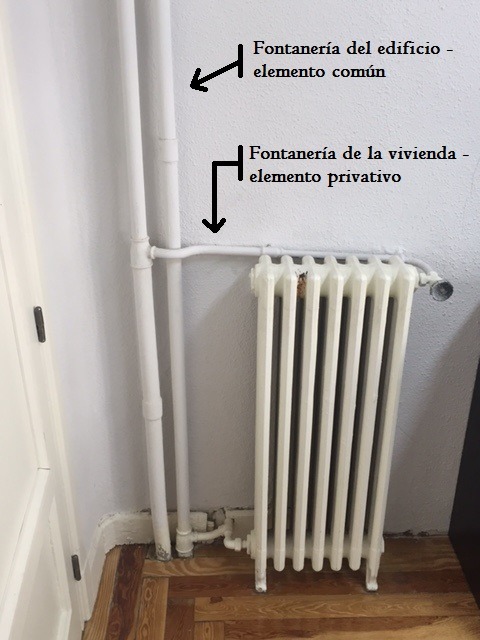
We see in the graphic the installation of central heating in a house. The pipe that runs through the entire building from top to bottom to bring hot water to all homes is a common element. However, the section of pipe whose sole purpose is to supply the radiator is a private element. The radiator would also be a private element of the home since its only function is to heat a space that belongs to a single owner.
In this case we have used an old installation for better understanding. In modern construction, the pipes are hidden in the walls, but the application would be the same.
The conclusions will be the same regardless of the element in question, and therefore the explanation about the heating installation is also applicable to bathroom and kitchen installations.
The buildings have pipes for rising and falling water, in which private pipes are attached that serve to supply the different devices and facilities such as showers, toilets, sinks, or kitchen appliances such as washing machines and dishwashers.
Floor and other structural elements
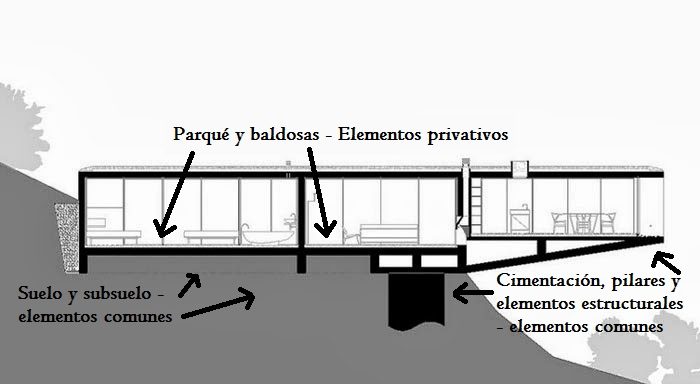
One of the elements that generates the greatest conflict is the floor. The base on which the building is built is a common element, however, both the tile and the parquet or any other element that is superimposed on the ground will be exclusive.
We have chosen the previous elements of distinction because most of the humidity comes from the ground/subsoil or from broken manholes, pipes, downspouts and other plumbing elements< /strong>.
In any case, it will be necessary to have the opinion of a technician who determines the cause that is generating the water leaks that in turn cause humidity.
Compensation for plumbing leaks
Once we have diagnosed that the leaks come from a plumbing defect, we will determine who should bear both the cost of repairing the fault and the cost of repairing the damages.
This type of failure can cause extensive damage to several homes at the same time. If the fault is in a pipe of a common nature, the community of owners must bear all the costs.
When the level of humidity or leaks prevents the occupation of the dwelling, compensation can be claimed cumulatively corresponding to the cost of an alternative rent or the contracting of rooms hotel. In the same way, additional compensation could be assessed for moral damages suffered by the occupants of the affected homes.
Compensation for soil seepage
Filtrations from the ground normally affect the floors located in the basement of the houses. They are common in cities with higher groundwater levels, as is the case of Madrid, and are a common problem in old buildings that have old structural elements and poor construction quality.
Technically they are usually called capillary leaks and their condition increases in rainy seasons. The problem arises from the lack of sealing in the soil foundation, so that groundwater penetrates from the subsoil and ends up affecting the elements of the lower houses and the basements.
More information on claims for this cause can be found in our article Compensation for humidity in the basement.
In such cases, and since the floor is considered a common element, it will be the community of owners who will have to bear the costs of repairing the damage and also the damages that would have been generated on the affected house.
There are currently companies that repair the problem by injecting waterproof resins or applying breathable mortars.
As we pointed out previously, those affected by this type of humidity can claim as many damages as they have suffered, including moral damages and the cost that they would have required of having to leave the house.


